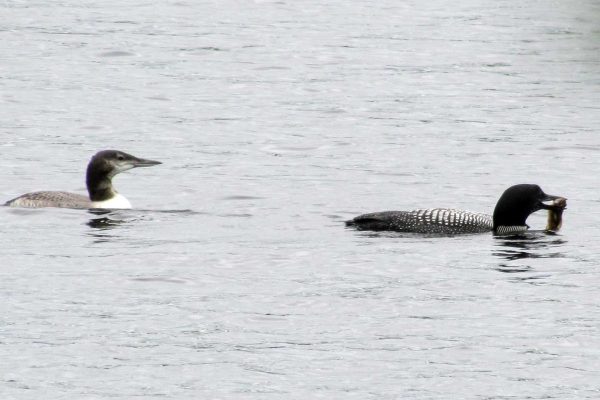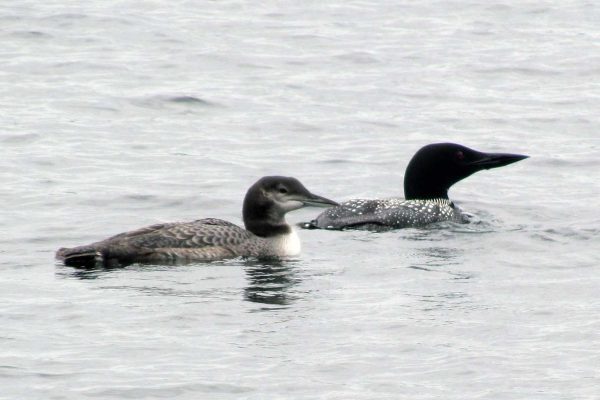During the last waning days of summer, we sat on a deck overlooking a beautiful lake where Common Loons thrive. We heard them calling through the night and watched as they meandered in the ripping waters just past the dock.
And we observed the loon parents as they helped their young one to become a loon.

The parent loon wouldn’t give the fish directly to the youngster at first but seemed to be trying to get it to dive and hand it off underwater or to try to pick it up from the water rather than directly from the adult. Photo courtesy of Jeff Wells
The scene began the week before. Sister-in-law Nina called from the camp to tell us a loon was lolling about near the shore, looking a bit unkempt and flailing its legs a bit. She was concerned that the bird might be injured or caught in some fishing line like the one she had rescued a few years back.
From some photos and a video clip she sent, we could tell that the loon in question, though nearly as large as an adult, was a young bird, one that had hatched this summer. Soon after, she saw two adult loons feeding the youngster crayfish and small minnows. She had contacted the local game warden as well, and he suggested that she keep an eye on it but agreed with us that it seemed like a young bird that was learning how to be a loon.
In the days that followed, during our time at the camp, we were excited to see that same young loon swimming about with its parents. One adult in particular seemed to be its mother. The youngster was looking robust, and we were thrilled to finally see it peering into the water and fully diving—a behavior that they must learn in order to become self-sufficient but that Nina had not seen it engage in.
One day, we had the good fortune to be able to watch for some time as the two parents engaged with their offspring. The adult that we had decided (rightly or wrongly) was the mom brought small fish over to the young loon but wouldn’t give it over immediately. A few times, she kept the fish and made a shallow dive nearby as though trying to get the youngster to try to get the fish underwater. Who knows if our interpretation of what was going on was right, but it would seem to be a sensible way to teach a young loon how to catch fish. (Watch video of a Common Loon parent showing its youngster how to fish for a meal beneath the surface.)

The young common loon with one of its parents that the authors watched as it was learning to be a loon on a central Maine lake this August. Photo courtesy of Jeff Wells
While all this was going on with the loon family, an all-brown, young-of-the-year Bald Eagle gave its screechy, complaining calls throughout the day from a small spruce- and pine-covered island a short distance from shore. While we watched, it showed no indication that it had learned how to hunt or scavenge but instead seemed to just be hoping its loud calls would bring one of its parents back to the nesting island to feed it. Was this normal parenting for eagles? Was the adult trying to get the young birds to begin moving away from the familiar and start some early clumsy foraging attempts? (Watch video of the young Common Loon as it practices fending for itself.)
We knew when an adult Bald Eagle had returned to its young on the island because this triggered the adult loons to give their loud cries of alarm, as eagles sometimes make meals of the young of other birds. On the other hand, the adult loons ignored the young eagle and would even feed their youngster without showing signs of alarm.
We were thrilled to be able to observe these loons and eagles as they carried out their parenting work of raising their young and helping them understand how to make their way in the world.
It was especially fitting as, back home, we had our own parenting responsibilities: helping our son prepare for his final year at college!
—Jeff and Allison Wells














Leave a Reply